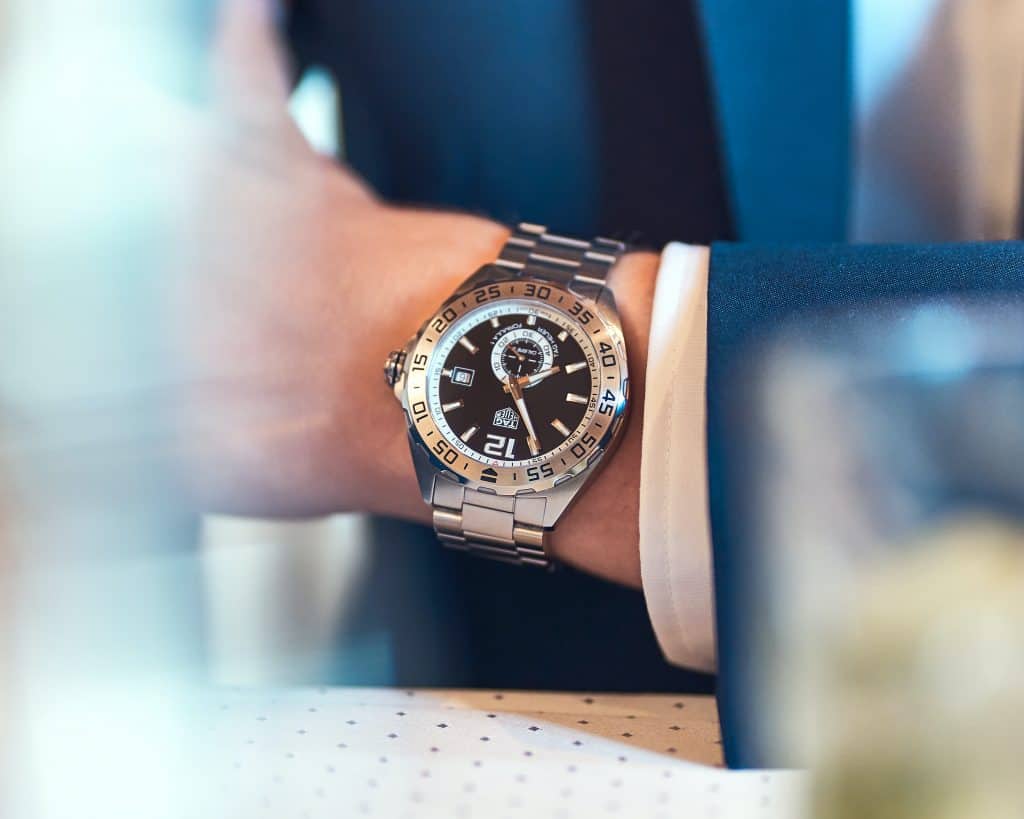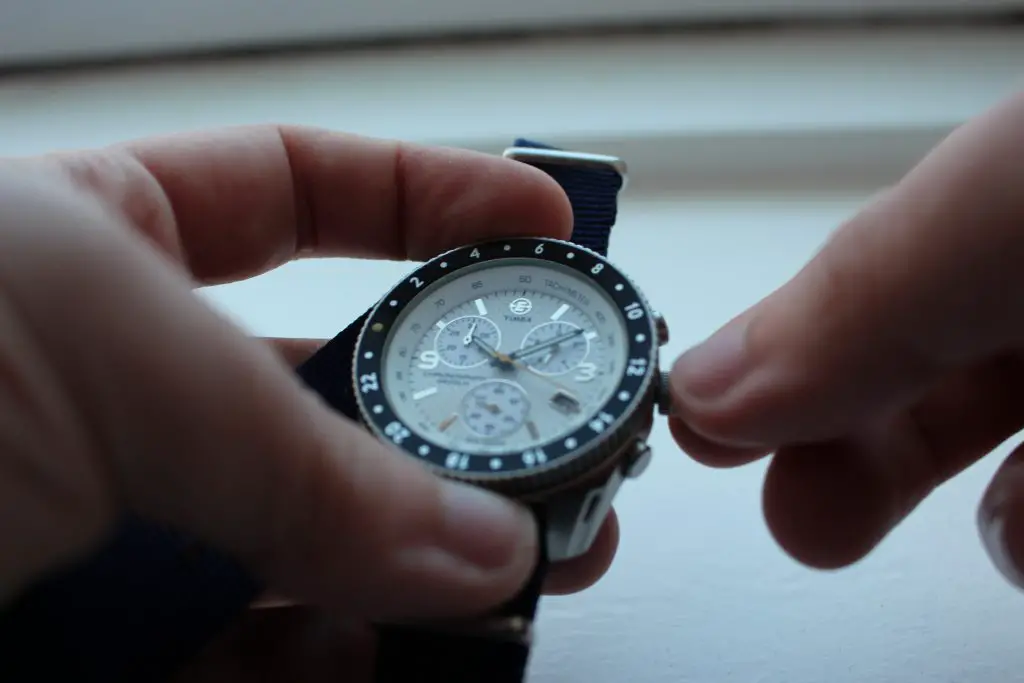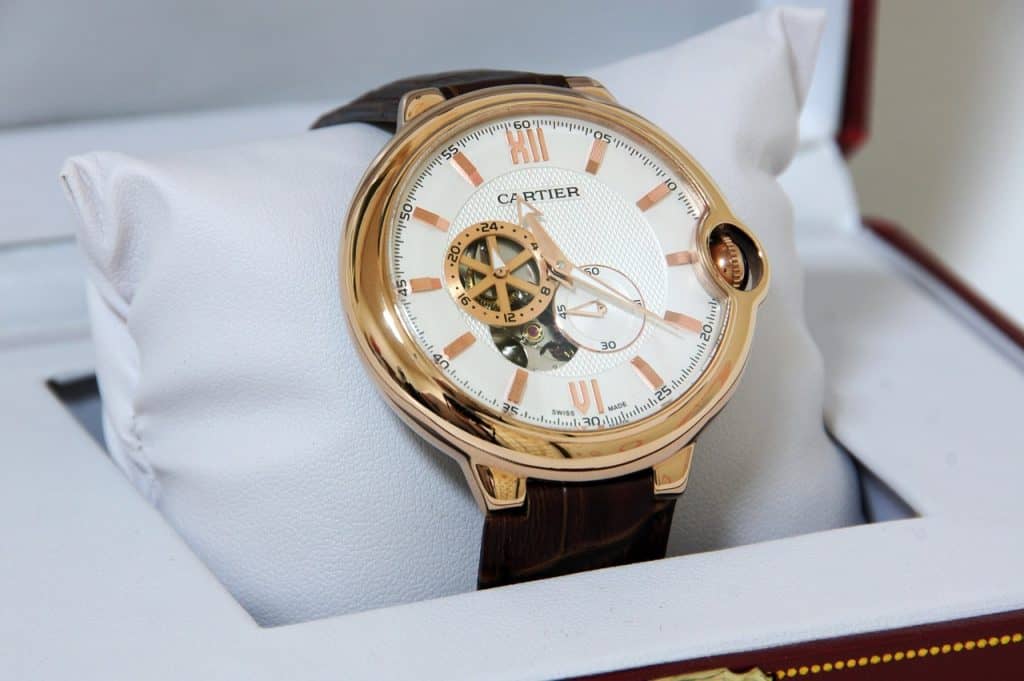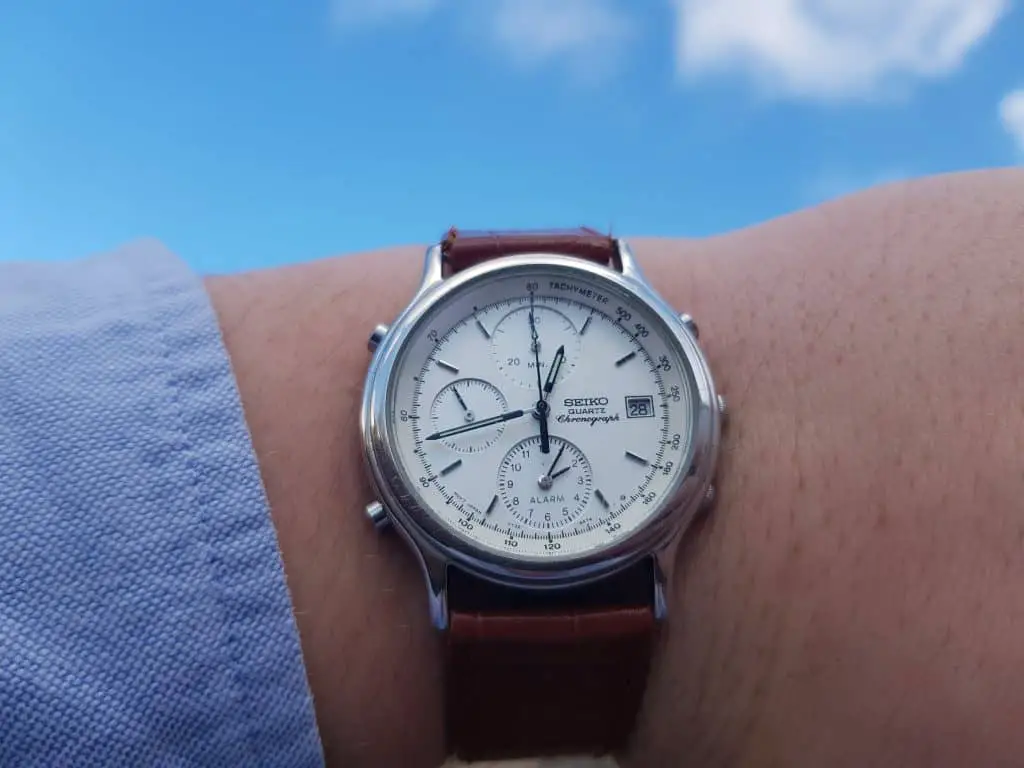Watches come in wide-ranging shapes, sizes, brands, and colors and contain a transparent cover protecting the face. While often overlooked, these clear faces keep the watch working and protect the watch’s face, and they are a critical part of any timepiece. They come in many different materials, and some are better than others.
Watch glass material is acrylic, sapphire crystal, or mineral glass. Acrylic watch glass is the most inexpensive option, while mineral glass is widely used for medium-price point watches. Sapphire crystal watch glass is expensive, but it is the most scratch-resistant.
This article will tell you everything you need to know about watch glass materials. So, let’s compare all of the most common watch glass substances and discuss which one is best.

Table of Contents
What Is Watch Glass?
Watch glass is the circular (or sometimes square-shaped) transparent material covering a watch face. Its primary function is to protect the tiny and delicate inner parts from damage, moisture, and dust. It’s sometimes also called the watch crystal.
Watch crystals can be flat or domed and come in various thicknesses.
Domed (or curved) watch glass looks interesting, reflects light glare less, and is more substantial. However, it can sometimes distort your watch face view.
Flat watch crystals offer excellent watch face legibility and often have raised edges. They’re usually the first choice of watch users who need their timepiece to fit comfortably underneath their shirt cuff.
Watch glass thickness varies greatly, ranging from 1mm (0.04 inches) to 4mm (0.16 inches). A 2mm (0.08 inch) thick watch crystal is ideal for everyday use, while thicker glass is most common for diving watches.
What Are the Most Common Watch Glass Materials?
Now that I’ve explained what watch glasses are, we can discuss the most common types.
The most common watch glass materials are:
- Acrylic or plastic
- Sapphire crystal
- Mineral glass
Some watch manufacturers have created their own patented watch glass material, but it’s rare to find such a watch.
Let’s take a look at the three main watch glass types in more detail:
Acrylic or Plastic
Acrylic watch glass is made from polymethyl methacrylate, a plastic polymer. It has several other names, too, such as:
- Plexiglass
- Hesalite
- Acrylite
- Perspex
- Lucite
Manufacturing acrylic watch crystals involves melting polymethyl methacrylate and allowing it to cool. The cooled acrylic is soft, flexible, and easily manipulated into any watch glass shape.
Most domed watch crystals are acrylic as it’s much more challenging and expensive to create this shape with mineral glass or sapphire crystal.
Acrylic watch crystal scores three out of ten on the Mohs Scale (refers to a mineral’s hardness and resistance to scratching).
Although it has a low Mohs Scale score, acrylic watch glass is durable and difficult to break or shatter. It is, however, susceptible to scratching, but its flexible nature makes buffing out scratches easy.
You can sometimes buff out hairline or superficial scratches with a finger, but you’ll need to heal up deeper blemishes with acrylic watch crystal polish.
Unless the watch has sentimental value, many watch owners simply buy a new one as the cost of replacing the timepiece or buying acrylic watch polish is often at least half of the watch’s value.

The durability of acrylic watch glass makes it a popular choice for diving and military watches. It can easily withstand high pressure when diving and in rough combat conditions in the military.
When new, acrylic watch crystal is almost entirely transparent. However, it may look yellow or cloudy after a few years, depending on acrylic quality.
UV exposure, temperature fluctuations, and mineral deposits from water can cause a yellow or cloudy appearance. Still, you can mitigate this by limiting your watch’s exposure to the sun and polishing it regularly to remove the mineral deposits.
Acrylic watch crystals are the most inexpensive watch glass for mass production and are very common in entry-level and children’s watches.
Unlike sapphire crystal, acrylic watch glass adapts to your body temperature, and its lightweight characteristics make it comfortable to wear.
Let’s discover below the pros and cons of acrylic as watch glass material:
Pros
- Inexpensive to manufacture. Acrylic’s low cost makes it easy to manufacture, and using acrylic watch glass can bring down the watch’s price. That makes it an attractive option if you enjoy changing timepieces frequently.
- Durable and highly shatter-resistant. Unlike mineral glass or sapphire crystal that can shatter when dropped or damaged, acrylic typically only forms a crack, with no tiny glass pieces breaking off.
- Lightweight. Some folks prefer lightweight watches as they’re more comfortable. Timepieces with acrylic glass material tend to be lighter and suitable for people with arthritis and carpal tunnel syndrome.
- It’s an excellent choice for kids’ watches. Kids can be clumsy and can easily damage their watches while playing. Acrylic watch glass is a perfect option for kids due to its durability and low replacement cost.
- Easy to buff out scratches. Acrylic watch glass offers weak scratch resistance, but luckily, it’s easy to buff out scratches.
Cons
- Prone to yellowing or cloudiness. If your watch has acrylic glass, you’ll need to polish it regularly to prevent it from yellowing or becoming cloudy. After about five years, however, yellowing and cloudiness are inevitable.
- Weak scratch resistance. Acrylic watch glass is highly vulnerable to scratches, which are easy to remove. However, deep scratches are more challenging to buff out and may be permanent.
- It can look cheap. Most people can tell if a watch crystal is made from plastic or a more expensive material with just one glance.
Sapphire Crystal
Sapphire crystal was first created in the 1800s by the French chemist Auguste Verneuil.
He created glass sheets with exceptional clarity after heating aluminum oxide powder and placing it under high pressure. To increase the glass’s durability, Mr. Verneuil heated it again to remove internal stress, resulting in the sapphire crystal we know today.
Sapphire crystal is the most durable watch glass material and is the second hardest material on earth. Diamonds are the only substance harder than sapphire crystal, and it’s no surprise that sapphire crystal scores nine out of ten on the Mohs Scale.
Manufacturing sapphire crystal is complex, and its extreme durability makes it very expensive. Luxury watches are typically the only timepieces with this sought-after watch crystal.
Most sapphire crystal watch glass is synthetic (and not genuine) sapphire. However, the crystallization process in manufacturing synthetic sapphire makes it equally as hard as natural sapphire.
During crystallization, sapphire crystal forms round pieces, after which they are thinly sliced using diamond saws (the only tool able to cut it) and polished. The high cost of diamond saws and the intricate polishing process affect sapphire crystal’s high price.

Despite the sapphire crystal’s extreme scratch resistance and hardness, it may shatter into tiny pieces if it experiences a heavy blow. Replacing sapphire crystal is expensive, but it’s often worth the money as it is the best quality watch crystal.
With its extreme durability, sapphire crystal watch glass can be incredibly thin and provide adequate protection. Whether the sapphire crystal watch glass is thick or thin, it can be challenging to detect that it’s even there, a testament to its brilliant and enduring clarity.
Sapphire crystal has a high refraction rate and is more reflective than acrylic or mineral glass. However, most sapphire crystals have an anti-reflective coating. Many watchmakers place the anti-reflective coating on the inner surface to not wear down on the outer surface.
Sapphire crystal typically has an icy cold feeling when you touch it, and it can feel heavy on your wrist as the sapphire crystal is a dense mineral.
So, here are the pros and cons to using a sapphire crystal for watch glass material:
Pros
- Highly scratch-resistant. Sapphire crystal is the best watch glass material in terms of scratch resistance.
- Excellent clarity. Sapphire crystal has a “barely there” quality, and the watch user often cannot even see that it’s there.
- Sapphire crystal is the second-hardest material on earth. As the second-hardest material, sapphire crystal is extremely hard-wearing and durable.
- You can place the anti-reflective coating on the inner side of the watch crystal. Watchmakers often put the anti-reflective coating on the inner surface to protect it from wear and tear.
Cons
- Expensive. Sapphire crystal is the most costly watch glass material and pushes up the watch price.
- It can crack or shatter. Although sapphire crystal is highly scratch-resistant and durable, it can break after heavy impact.
- It’s Impossible to repair cracks. If a sapphire watch crystal cracks or shatters, you’ll need to replace the entire glass as it’s impossible to fix. Replacing a sapphire crystal watch glass can be incredibly expensive.
- It increases the watch’s weight. Sapphire crystal is a heavy mineral that increases the watch’s weight.
Mineral Glass
Mineral glass is the most commonly-used watch crystal type for medium-price point timepieces. It’s the perfect compromise between acrylic’s affordability and sapphire crystal’s excellent quality and durability.
It offers to watch owners a similar aesthetic appeal and a high-quality feel to sapphire glass, but it’s significantly cheaper. Mineral glass doesn’t feel cold when touched, unlike sapphire crystal, and adapts to the wearer’s body temperature.
Mineral glass is also called Hardlex. This material is manufactured using silica and glass compounds. It is tempered (or hardened) during the manufacturing process and then chemically treated to be durable and scratch-resistant.
Mineral glass has a slightly blue tinge when viewed in direct sunlight or against a dark background. If it doesn’t have an anti-reflective coating, mineral glass crystals can reflect light and make it difficult to read the time on the watch.
Mineral glass scores five out of ten on the Mohs Scale and is a popular material for glass windows. It can withstand rough conditions, but it can shatter if it experiences extreme fluctuations in temperature.

Although mineral glass is not as hard as sapphire crystal, it’s roughly seven times harder than acrylic watch glass. However, if it experiences a strong impact, mineral glass is more likely to shatter than sapphire crystal.
Repairing a cracked mineral glass crystal is impossible, and you will need to replace it. Depending on your watch’s age and dial shape, replacing the glass material can be costly and challenging.
Mineral glass is a hard-wearing material, but it is still vulnerable to scratching. Watch owners can sometimes buff away fine scratches, but deeper scratches are permanent.
Mineral glass offers pros and cons when you use it for watch glass material:
Pros
- It’s the perfect compromise between a sapphire crystal and acrylic watch glass. Mineral glass is an excellent and cost-effective alternative if you can’t afford a sapphire crystal watch glass.
- Mineral glass is more shatter-resistant than sapphire crystal. Mineral glass is not as hard as sapphire crystal, but it offers more shatter resistance.
Cons
- Mineral glass can shatter after extreme temperature fluctuations. Its mineral glass crystal may break if you wear your watch in hot and cold conditions.
- It has a medium scratch resistance level. Scoring five out of ten on the Mohs Scale, mineral glass is durable but more prone to scratches than sapphire crystal.
- The anti-reflective coating edge can look like a scratch when it wears off. Most mineral glass watch crystals have an anti-reflective coating on the outer surface. When it wears off, the coating edge can resemble a scratch.
How To Choose the Right Watch Glass Material
If you’re looking for the cheapest possible option, an acrylic face will suffice. Go for a sapphire crystal if you’re looking for the most scratch-resistant and overall best material. If you’re looking for a more affordable but still great option, go for mineral glass.
Although the manufacturer of the watch decides what material they will use, you can just change it later on. Technically, you could have the watch face of a Timex watch replaced by a sapphire crystal. I’m not sure why you would do that, but it is possible.
Just keep in mind that with replacing the watch’s face comes the cost of replacing, but also the cost of the materials.
Lower-end watches usually use acrylic for the watch face, simply because it’s the cheapest. High-end luxury watches almost always use a sapphire crystal (and rightfully so), while most respected but not quite luxury brands (think Citizen or Fossil) typically use mineral glass.
Conclusion
The three primary watch glass materials are acrylic, sapphire crystal, and mineral glass.
Acrylic is the most cost-effective and lightweight watch material. It’s easy to buff scratches from acrylic, but it is prone to yellowing and clouding after a few years.
Sapphire crystal is the most expensive watch glass material and is incredibly durable and scratch-resistant. With a heavy impact, however, it may shatter and be irreparable.
Most mid-range watches have mineral glass watch crystals. This watch glass material is an excellent compromise between the cost-effectiveness of acrylic and the sapphire crystal’s high quality.
